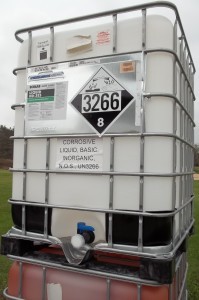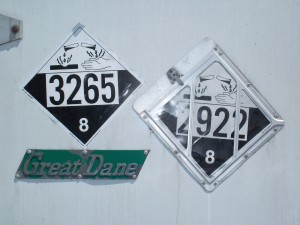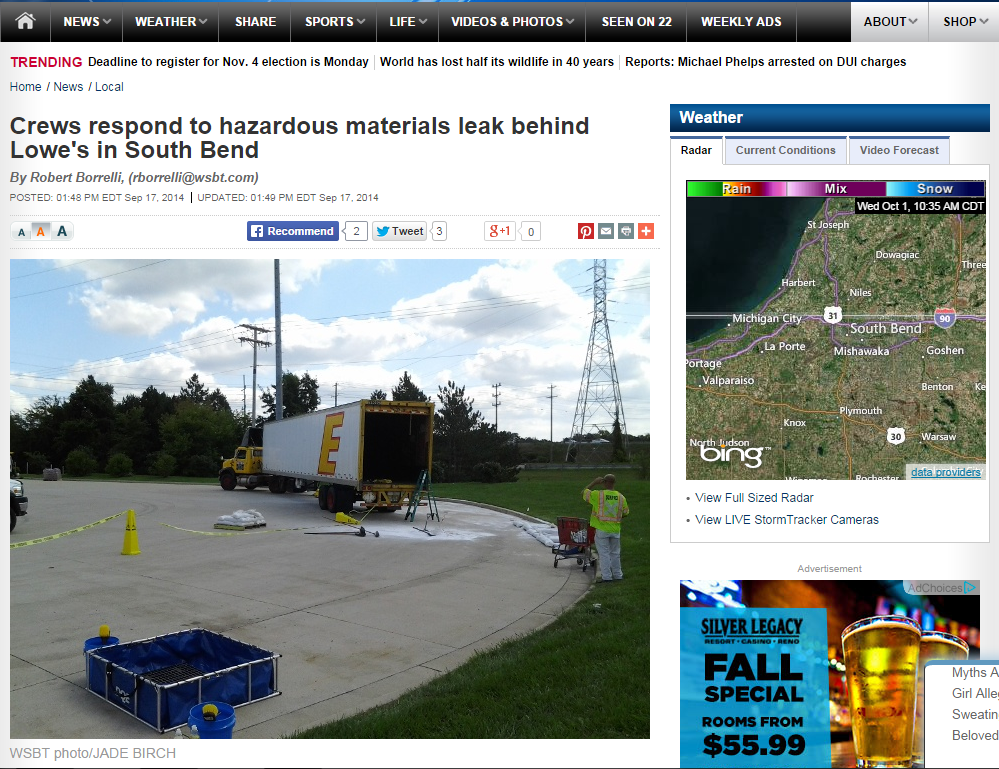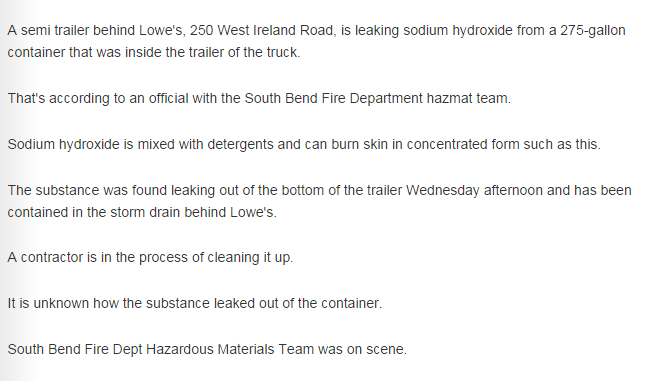This is how the release was reported on the WSBT website:
With the accompanying text:
Read the article yourself here: Crews Respond to Hazardous Materials Leak Behind Lowe’s in South Bend
A leak of some sodium hydroxide. Seems pretty simple, right? But a close look at the picture and text of the article gives me pause. I believe there is the potential for a violation of the Hazardous Material Regulations of the PHMSA/USDOT, and it’s not the leak. Read the original article closely then see what I can discern from it. After you’ve read my article tell me if you think I got it right or not. What I intend to do here is compare the available information to the applicable regulations (the HMR) and then provide my conclusion.
First of all, the article identifies the spilled material as sodium hydroxide and later identifies it as being in a “concentrated form”. Sodium hydroxide is identified by its technical name in the hazardous materials table (49 CFR 172.101 of the Hazardous Materials Regulations) and is therefore a hazardous material – or HazMat – when transported or offered for transportation in commerce.
Entry from the Hazardous Materials Table at 49 CFR 172.101:
Also, I’ll assume that since the sodium hydroxide is in a “concentrated form” it will meet the definition of a hazard class 8 Corrosive Material as found at 49 CFR 173.136 which reads in part,
“corrosive material” (Class 8) means a liquid or solid that causes full thickness destruction of human skin at the site of contact within a specified period of time. A liquid, or a solid which may become liquid during transportation, that has a severe corrosion rate on steel or aluminum…is also a corrosive material.
So, we clearly have a hazard class 8 Corrosive Material with a technical name of Sodium hydroxide solution.
Contact me with any questions you may have about the transportation of hazardous materials by air, highway, vessel, or rail International and Domestic Daniels Training Services 815.821.1550 |
A hazardous material is subject to the HMR when transported in commerce by highway – as is clearly the case here. The specific requirements will vary, but at a minimum must include:

- Creation of a shipping paper that describes the HazMat by the Shipper and retention of it by the Carrier.
- Selection of authorized packaging (found in Column 8 of the hazardous materials table).
- HazMat labels and markings affixed to the packagings used to contain the HazMat.
- Placarding of the vehicle transporting the HazMat, if applicable.
- Shipper must provide emergency response information and a 24/7/365 emergency response phone number on or with the shipping paper.
- Registration as a Shipper or Carrier of HazMat depending on the type and quantity of HazMat.
- HazMat Employee training for all persons whose job responsibilities directly affect the safe transportation of the HazMat. This includes persons who:
- Load or unload the HazMat.
- Determine the authorized packaging for the HazMat.
- Identify the HazMat and classify its potential hazards.
- Complete, sign, review, or certify the shipping paper.
- Apply HazMat labels and markings to the packaging.
- Determine the correct placards – if required – and affix them to the vehicle.
- Operate a motor vehicle transporting any quantity of a HazMat over a public roadway.
- Directly supervise persons who perform a regulated function.
The article also states that the sodium hydroxide was in a single packaging of 275 gallons (I’ll assume this was its maximum capacity). A HazMat packaging of this maximum capacity for a liquid meets the definition of a bulk packaging (read my article: Bulk Packaging for HazMat Explained!).
This last fact is important because it is here that the available information indicates a potential violation of the HMR.

Before we get to that, I believe I can also make a reasonable assumption about the type of bulk packaging used for this shipment. Column 8C of the hazardous materials table indicates the section of Part 173 of Title 49 where the packaging that is authorized for the HazMat shipment is described. Since sodium hydroxide solutions has separate entries for each of its two possible packing groups (packing group II for moderate danger and packing group III for least danger) it references two different sections of 49 CFR Part 173 where a Shipper can determine the authorized packaging for the transportation of that HazMat. The two options for sodium hydroxide solutions are 49 CFR 173.242 (for packing group II) and 49 CFR 173.241 (for packing group III). It’s made easier because both sections include the same packaging categories as authorized:
- Rail cars
- Cargo tanks
- Portable tanks
- Intermediate Bulk Containers (IBCs)
- Large packagings
Given the available options for authorized packagings from the HMR, whit I can observe from the photo, and assuming that the Shipper is in compliance with the regulations, my reasonable assumption is that the sodium hydroxide solution was contained in an IBC.
That’s about all I can determine from the image and the reporting. Now for the potential violation of the HMR. If I’m correct and this was a bulk packaging of a hazard class 8 Corrosive Material (hazard class 8 Corrosive is found in Table 2 of the Placarding Tables at 49 CFR 172.504(e)), then pursuant to 49 CFR 172.504(c) the motor vehicle must display the hazard class 8 Corrosive placard on each side and each end. Also, the transportation of a bulk packaging inside a vehicle requires the display of the four digit identification number of the hazardous material (found in Column 4 of the hazardous materials table) on each side and each end of the motor vehicle. Pursuant to 49 CFR 172.332, the identification number may appear on the placard, on an orange panel near the placard, or on a white square-on-point marking with dimensions the same as those of a placard. Look closely at the picture of the incident above and you’ll see no sign of the Corrosive placard or the identification number on display. As a matter of fact, just above the rear bumper and to the lower left of the open cargo door you will notice a flip-type placard display that is not in use. Pursuant to 49 CFR 172.506 it is the responsibility of the Shipper to offer the proper placards to the driver prior and for the driver to ensure the proper placards are affixed to their vehicle; it appears that this was not done in this case.

Something else to watch for in this situation is if the required written hazardous materials incident report is submitted to the PHMSA/USDOT within 30 days as required by 49 CFR 171.16. At §171.16(a)(2) one reads that an unintentional release of a hazardous material qualifies as a reportable HazMat incident. After October 17th, a person accessing the PHMSA/USDOT Incident Statistics website can enter the identifying features of this leak (ie. date, location, type of HazMat) and determine if the Carrier submitted the required report.
Like this article? Subscribe to my Monthly Newsletter No marketing emails! |
Spills and leaks like this happen frequently during the transportation of hazardous materials. When it does, it’s more important than ever that both the Shipper and the Carrier are in compliance with the HMR. If you’re a Shipper or a Carrier of HazMat, please contact me to discuss your status and the training you need to come back into compliance.



